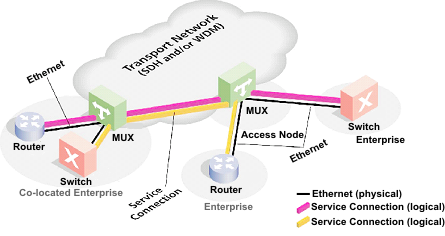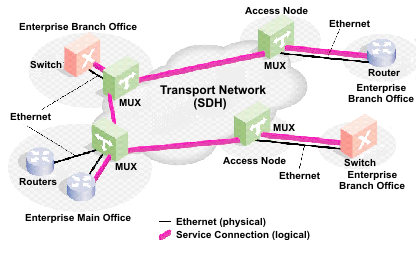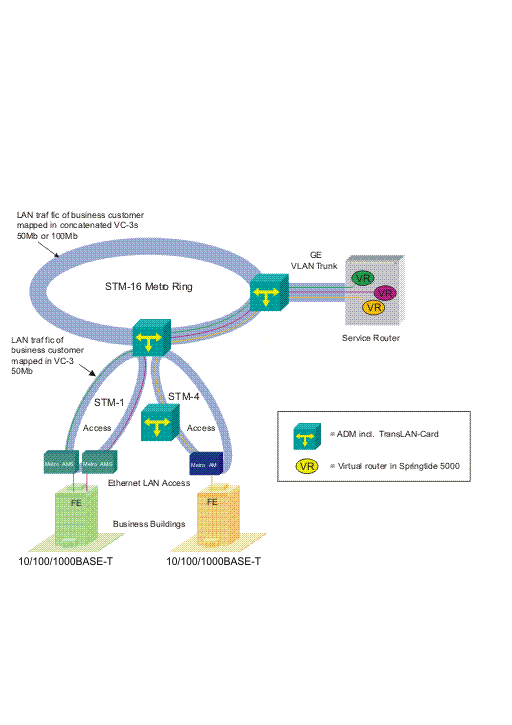Multi-service application with the TransLAN® option board
The TransLAN® option board, enables the SDH network elements to provide Ethernet over SDH, and offers variable data applications on top of the traditional TDM applications. This results in cost-effective, simple and reliable multi-service solutions for customers. TransLAN® can provide VLAN functions, and bandwidth can be shared for different customers.
Direct LAN-to-LAN interconnect (two LAN's)
The most straightforward application of the TransLAN® option board is to interconnect two LAN segments that are at a distance that cannot be reached with a simple Ethernet repeater, since that would violate the collision domain size rules. Both LAN's do not have to be of the same speed. It is possible to interconnect a 10BASE-T and a 100BASE-T LAN this way. This application is shown in the figure below:

Direct LAN-to-LAN interconnect (Multiple LAN's)
A next step in complexity is to interconnect multiple LAN's, more than two, at different locations. It is possible to associate a single LAN port with two or more WAN ports. In this way multiple sites can be interconnected, forming a fully Layer 2 switched WAN Ethernet network. This application is shown in the figure below.

LAN-ISP interconnect
An extension of the previous application is to have one LAN drop of a multi-point LAN-to-LAN interconnection at the point of presence of an ISP (Internet Service Provider), to provide for instance Internet access to the users in the company LANs.
Multiple customers sharing a WAN connection
To increase the efficiency of the bandwidth usage, it is possible to route the Ethernet traffic of multiple end-users over the same SDH facilities. This feature is called LAN-VPN and makes use of customer VPN tags, a tagging scheme derived from the IEEE802.1Q VLAN standard to separate the traffic of the different users. Via the IEEE 802.1ad provider bridge mode it is additionally possible to use provider-defined tags for different customers and thus to be independent from customer VPN tags. A respective application is shown in the figure below.

VLAN Trunking
At the ISP premises, the aggregated LAN traffic from multiple customers (i.e. multiple VLANs) via one single high capacity Ethernet link (Fast Ethernet) to data equipment in a Central Office or ISP POP such as an IP edge Router, IP Service Switch or ATM Switch, can be handled by means of the VLAN trunking feature. VLAN trunking is a possible application of the IEEE 802.1Q and IEEE 802.1 ad VLAN tagging scheme. Main benefit of the VLAN trunking feature is that TransLAN® cards can hand off end user LAN traffic via one high capacity LAN port instead of multiple low speed LAN ports, thus reducing port, space and cabling costs. The following figure illustrates an example of VLAN Trunking.

DCN support with the TransLAN® unit
The TransLAN® option board can also be used for DCN engineering purposes. An important application in this respect is to use the Ethernet interfaces to make a long distance Q-LAN connection. This solution can replace the current solution that uses external modems or routers. It is often cheaper and easier to manage if the long distance Q-LAN connection can be made over the SDH infrastructure (at the cost of the bandwidth of a few VC-12s). The DCN application of the TransLAN® option board assumes the Alcatel-Lucent OMS is collocated with at least one of the NEs equipped with a TransLAN® card (e.g., 1643 AM/1643 AMS, 1663 ADMu). In such a case, one can connect the Ethernet port of the Alcatel-Lucent OMS to one of the designated 10BASE-T/100BASE-TX LAN ports and configure the associated WAN port with desired bandwidth (e.g., VC12) to carry the management traffic.
Additionally it is possible to integrate 1643 Access Multiplexer AM/1643 Access Multiplexer Small AMS in other vendorś networks and to pass through their DCCR transparently.

Alcatel-Lucent – Proprietary
Use pursuant to applicable agreements